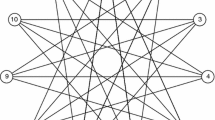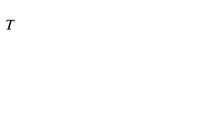Abstract
This is an overview of the significance and main uses of projection, lifting and extended formulation in integer and combinatorial optimization. Its first two sections deal with those basic properties of projection that make it such an effective and useful bridge between problem formulations in different spaces, i.e. different sets of variables. They discuss topics like projection and restriction, the integrality-preserving property of projection, the dimension of projected polyhedra, conditions for facets of a polyhedron to project into facets of its projections, and so on. The next two sections describe the use of projection for comparing the strength of different formulations of the same problem, and for proving the integrality of polyhedra by using extended formulations or lifting. Section 5 deals with disjunctive programming, or optimization over unions of polyhedra, whose most important incarnation are mixed 0-1 programs and their partial relaxations. It discusses the compact representation of the convex hull of a union of polyhedra through extended formulation, the connection between the projection of the latter and the polar of the convex hull, as well as the sequential convexification of facial disjunctive programs, among them mixed 0-1 programs, with the related concept of disjunctive rank. Section 6 reviews lift-and-project cuts, the construction of cut generating linear programs, and techniques for lifting and for strengthening disjunctive cuts. Section 7 discusses the recently discovered possibility of solving the higher dimensional cut generating linear program without explicitly constructing it, by a sequence of properly chosen pivots in the simplex tableau of the linear programming relaxation. Finally, section 8 deals with different ways of combining cuts with branch and bound, and briefly discusses computational experience with lift-and-project cuts.
Similar content being viewed by others
References
Balas, E. (1998). “Disjunctive Programming: Properties of the Convex Hull of Feasible Points.” Invited paper, with a foreword by G. Cornuéjols and W. Pulleyblank, Discrete Applied Mathematics 89, 3–44. (Originally MSRR# 348, Carnegie Mellon University, July 1974).
Balas, E. (1979). “Disjunctive Programming.” Annals of Discrete Mathematics 5, 3–51.
Balas, E. (1985). “Disjunctive Programming and a Hierarchy of Relaxations for Discrete Optimization Problems.” SIAM Journal on Algebraic and Discrete Methods 6, 466–485.
Balas, E. (1987). “The Assignable Subgraph Polytope of a Directed Graph.” Congressus Numerantium 60, 35–42.
Balas, E. (1997). “A Modified Lift-and-Project Procedure.” Mathematical Programming 79, 19–31.
Balas, E. (1998). “Projection with a Minimal System of Inequalities.” Computational Optimization and Applications 10, 189–193.
Balas, E. (2001). “Projection and Lifting in Combinatorial Optimization.” In M. Jünger and D. Naddef (eds.), Computational Combinatorial Optimization: Optimal or Provably Near-Optimal Solutions, LNCS 2241, Springer, pp. 26–56.
Balas, E., S. Ceria, and G. Cornuéjols. (1993). “A Lift-and-Project Cutting Plane Algorithm for Mixed 0-1 Programs.” Mathematical Programming 58, 295–324.
Balas, E., S. Ceria, and G. Cornuéjols. (1996). “Mixed 0-1 Programming by Lift-and-Project in a Branch-and-Cut Framework.” Management Science 42, 1229–1246.
Balas, E., S. Ceria, G. Cornuéjols, and G. Pataki. (1996). “Polyhedral Methods for the Maximum Clique Problem.” In D. Johnson and M. Trick (eds.), Clique, Coloring and Satisfiability: The Second DIMACS Challenge. The American Mathematical Society, Providence, RI, pp. 11–27.
Balas, E. and R.G. Jeroslow. (1980). “Strengthening Cuts for Mixed Integer Programs.” European Journal of Operational Research 4, 224–234.
Balas, E. and J.B. Mazzola. (1984). “Nonlinear 0-1 Programming: I. Linearization Techniques, II. Dominance Relations and Algorithms.” Mathematical Programming 30, 1–21 and 22–45.
Balas, E. and M. Oosten. (1998). “On the Dimension of Projected Polyhedra.” Discrete Applied Mathematics 87, 1–9.
Balas, E. and M. Oosten. (2000). “The Cycle Polytope of a Directed Graph.” Networks 36, 34–46.
Balas, E. and M. Perregaard. (2003). “A Precise Correspondence Between Lift-and-Project Cuts, Simple Disjunctive Cuts, and Mixed Integer Gomory Cuts for 0-1 Programming.” Mathematical Programming B 94, 221–245.
Balas, E. and W.R. Pulleyblank. (1983). “The Perfectly Matchable Subgraph Polytope of a Bipartite Graph.” Networks 13, 495–518.
Balas, E. and W.R. Pulleyblank. (1989). “The Perfectly Matchable Subgraph Polytope of an Arbitrary Graph.” Combinatorica 9, 321–337.
Balas, E., J. Tama and J. Tind. (1989). “Sequential Convexification in Reverse Convex and Disjunctive Programming.” Mathematical Programming 44, 337–350.
Beaumont, N. (1990). “An Algorithm for Disjunctive Programming.” European Journal of Operational Research 48, 362–371.
Bixby, R., W. Cook, A. Cox, and E. Lee. (1999). “Computational Experience with Parallel Mixed Integer Programming in a Distributed Environment.” Annals of Operations Research 90, 19–45.
Blair, C. (1976). “Two Rules for Deducing Valid Inequalities for 0-1 Programs.” SIAM Journal of Applied Mathematics 31, 614–617.
Blair, C. (1980). “Facial Disjunctive Programs and Sequences of Cutting Planes.” Discrete Applied Mathematics 2, 173–180.
Ceria, S. and G. Pataki. (1998). “Solving Integer and Disjunctive Programs by Lift-and-Project.” In R.E. Bixby, E.A. Boyd, and R.Z. Rios-Mercado (eds.), IPCO VI, Lecture Notes in Computer Science, 1412. Springer, pp. 271–283.
Ceria, S. and J. Soares. (1997). “Disjunctive Cuts for Mixed 0-1 Programming: Duality and Lifting.” GSB, Columbia University.
Ceria, S. and J. Soares. (1999). “Convex Programming for Disjunctive Convex Optimization.” Mathematical Programming 86, 595–614.
Dantzig, G.B., R.D. Fulkerson, and S.M. Johnson. (1954). “Solution of a Large-Scale Traveling Salesman Problem.” Operations Research 2, 393–410.
Fortet, R. (1960). “Applications de l'algèbre de Boole en recherche opérationnelle.” Revue Francaise de Recherche Opérationnelle 4, 17–25.
Jeroslow, R.G. (1977). “Cutting Plane Theory: Disjunctive Methods.” Annals of Discrete Mathematics 1, 293–330.
Jeroslow, R.G. (1987). “Representability in Mixed Integer Programming I: Characterization Results.” Discrete Applied Mathematics 17, 223–243.
Jeroslow, R.G. (1989). “Logic Based Decision Support: Mixed Integer Model Formulation.” Annals of Discrete Mathematics 40.
Johnson, E.L. (1974). “The Group Problem for Mixed-Integer Programming.” Mathematical Programming Study 2, 137–179.
Letchford, A. (2001). “On Disjunctive Cuts for Combinatorial Optimization.” Journal of Combinatorial Optimization 5, 299–317.
Lovász, L. and A. Schrijver. (1991). “Cones of Matrices and Set Functions and 0-1 Optimization.” SIAM Journal of Optimization 1, 166–190.
Miller, C.E., A.W. Tucker, and R.A. Zemlin. (1960). “Integer Programming Formulations and Traveling Salesman Problems.” Journal of the ACM 7, 326–329.
Nemhauser, G. and L. Wolsey. (1986). Integer and Combinatorial Optimization. Wiley.
Padberg, M. and T.-Y. Sung. (1991). “An Analytical Comparison of Different Formulations of the Traveling Salesman Problem.” Math. Programming 52, 315–357.
Pataki, G. (2001). Personal communication, March.
Perregaard, M. (2003). “A Practical Implementation of Lift-and-Project Cuts. A computational exploration of lift-and-project with XPRESS-MP.” Paper presented at the International Symposium on Mathematical Programming, August, Copenhagen.
Perregaard, M. and E. Balas. (2001). “Generating Cuts from Multiple-Term Disjunctions.” In K. Aardal and B. Gerards (eds.), Integer Programming and Combinatorial Optimization (8th IPCO Conference, Utrecht, 2001), LCNS No. 2081, Springer, pp. 318–360.
Sherali, H. and W. Adams. (1990). “A Hierarchy of Relaxations Between the Continuous and Convex Hull Representations for Zero-One Programming Problems.” SIAM Journal on Discrete Mathematics 3, 411–430.
Sherali, H. and C. Shetty. (1980). Optimization with Disjunctive Constraints. Lecture Notes in Economics and Mathematical Systems, 181, Springer.
Stoer, J. and C. Witzgall. (1970). Convexity and Optimization in Finite Dimensions I. Springer.
Stubbs, R.A. and S. Mehrotra. (1996). “A Branch-and-Cut Method for 0-1 Mixed Convex Programming.” Department of Industrial Engineering, Northwestern University.
Thienel, S. (1995). “ABACUS: A Branch-and-Cut System.” Doctoral Dissertation, Faculty of Mathematics and The Natural Sciences, University of Cologne.
Turkay, M. and I.E. Grossmann. (1996). “Disjunctive Programming Techniques for the Optimization of Process Systems with Discontinuous Investment Costs-Multiple Size Regions.” Industrial Engineering Chemical Research 35, 2611–2623.
Williams, H.P. (1994). “An Alternative Explanation of Disjunctive Formulations.” European Journal of Operational Research 72, 200–203.
Author information
Authors and Affiliations
Corresponding author
Additional information
Research was supported by the National Science Foundation through grant #DMI-9802773 and by the Office of Naval Research through contract N00014-97-1-0196.
This is an updated and extended version of the paper published in LNCS 2241, Springer, 2001 (as given in Balas, 2001).
Rights and permissions
About this article
Cite this article
Balas, E. Projection, Lifting and Extended Formulation in Integer and Combinatorial Optimization. Ann Oper Res 140, 125–161 (2005). https://doi.org/10.1007/s10479-005-3969-1
Issue Date:
DOI: https://doi.org/10.1007/s10479-005-3969-1




